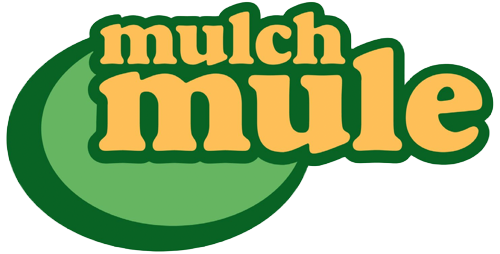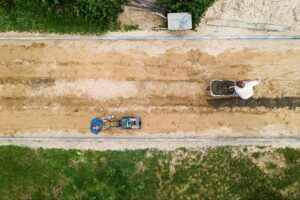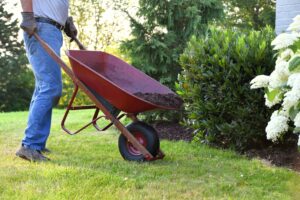Effective landscaping crew management is the backbone of any successful landscaping operation. In an era where competition is fierce and client expectations are high, adopting efficient strategies to streamline crew scheduling and reduce labor costs is essential. By refining crew management processes, businesses can decrease downtime, boost productivity, and deliver consistent, high-quality services. Whether you’re managing a small lawncare team or overseeing extensive commercial projects, aligning your crew’s efforts with clear goals and streamlined operations is key.
This article explores actionable strategies to enhance efficiency, covering modern scheduling tools, balanced workload distribution, predictive scheduling, future-focused practices, and innovative solutions like the Mulch Mule trailer. These insights will help you refine resource allocation, address daily challenges, and elevate overall crew performance.
Key Advantages of Streamlined Landscaping Crew Scheduling
Effective crew scheduling goes beyond assigning tasks; it entails resource allocation, balanced workload distribution, and maintaining clear communication. When implemented properly, optimized scheduling can yield several benefits:
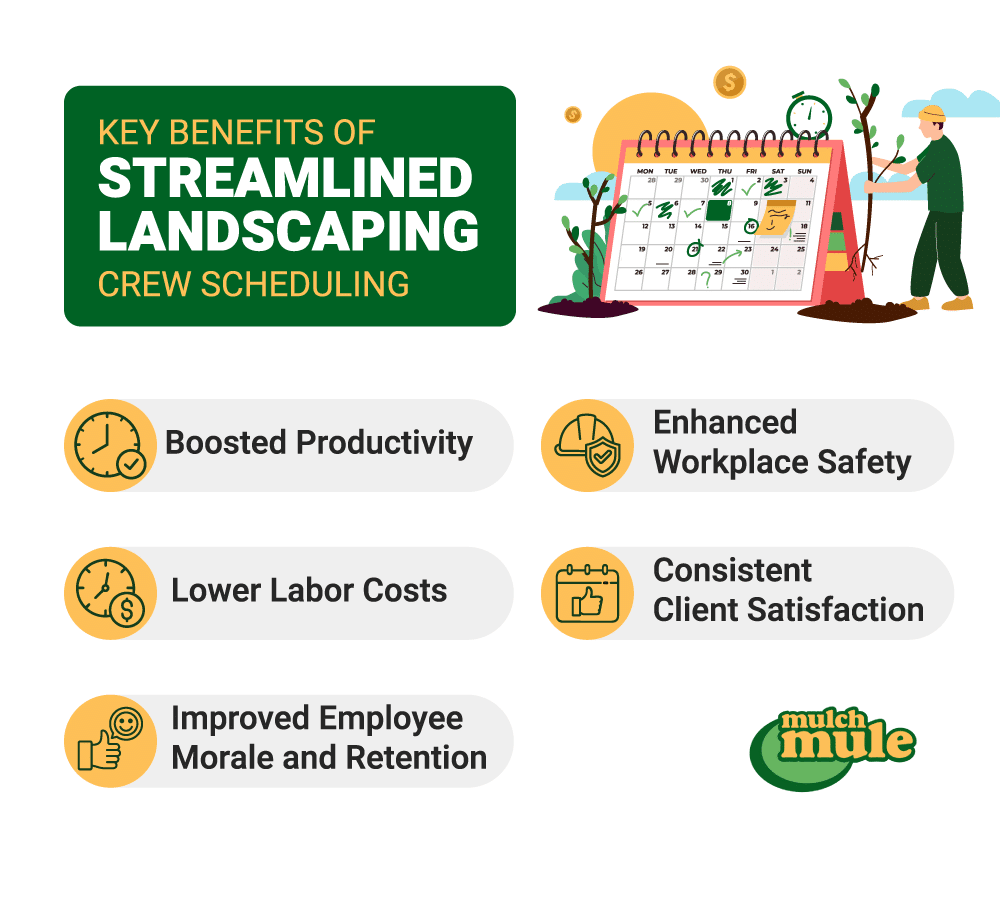
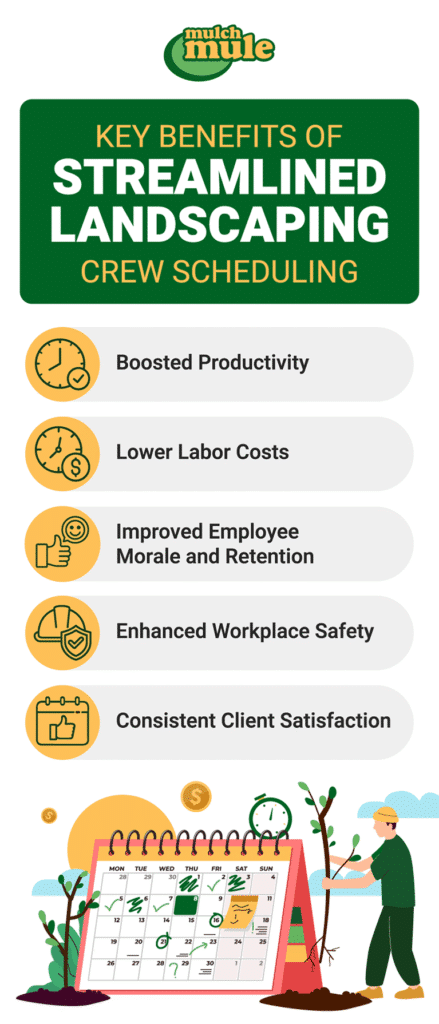
Boosted Productivity
A well-coordinated schedule ensures every team member understands their role, reducing confusion and eliminating redundant work. Strategic task assignments make it possible to complete projects ahead of schedule without sacrificing quality.
Lower Labor Costs
Efficient scheduling minimizes idle time and avoids unnecessary overtime, ensuring all crew members work at peak efficiency. By reducing delays, businesses keep labor costs in check, contributing to overall profitability.
Improved Employee Morale and Retention
Balanced workloads help prevent burnout, fostering a positive work environment. When employees feel their efforts are fairly managed, they remain committed, reducing hiring and training expenses while supporting long-term team cohesion.
Enhanced Workplace Safety
Optimized scheduling includes planned breaks and task rotations, reducing fatigue and the risk of injuries. This approach not only safeguards employees but also cuts down on workers’ compensation claims.
Consistent Client Satisfaction
Reliable scheduling ensures projects are completed on time, meeting client expectations. This reliability translates into better customer reviews and long-term business growth.
Actionable Strategies for Optimizing Scheduling
Adopting effective scheduling strategies is crucial for reducing labor costs and maintaining top-notch service quality. Below are practical methods to enhance your crew management.
Embrace Modern Scheduling Software
Modern scheduling software revolutionizes task allocation and progress tracking. These tools automate scheduling, dispatch assignments, and provide real-time updates. Crews can access their schedules, shift details, and any changes through smartphone apps, keeping everyone informed. Integration with payroll and job tracking systems ensures that shifts align with budgets and operational targets. Features like automated reminders and GPS tracking streamline communication and minimize human error.
Distribute Workloads Fairly Across Teams
Effective scheduling means assigning the right tasks to the right people. Avoid overburdening skilled employees while underutilizing others. Balance workloads by distributing both physically and mentally demanding tasks evenly. Consider task complexity, required physical exertion, and available equipment when planning assignments. Rotating teams for challenging work prevents prolonged strain and boosts team morale while promoting a fair distribution of responsibilities.
Implement Predictive Scheduling
Predictive scheduling uses data from past seasons, client demand trends, and project timelines to forecast labor needs. Analyzing historical trends—such as peak periods for mulching or leaf collection—allows you to prepare staffing plans in advance. This proactive method aligns resources with anticipated workloads, reducing last-minute scheduling chaos. For regions with unpredictable weather, predictive scheduling helps allocate the right number of crews during high-demand periods, ensuring flexibility when unexpected delays occur.
Utilize Staggered Shifts and Overlapping Schedules
Not every project requires a crew to work the entire day. Staggered shifts can break tasks into strategic time blocks, ensuring continuous progress without overstaffing. For instance, one team might handle morning material loading while another focuses on finishing tasks in the afternoon. Overlapping schedules enable different teams to work consecutively on various project stages, smoothing transitions between tasks and reducing delays.
Landscaping Scheduling Tips
As technology and market demands evolve, prepared leaders are already looking ahead to future solutions. Exploring solutions involves considering how automation, data analytics, and sustainable practices converge to create more agile operations.
- Advanced Data Analytics – Landscaping businesses can leverage deeper historical and real-time analytics to forecast trends. Integrating data from scheduling software and equipment usage enables precise predictions of labor needs, ensuring optimal staffing levels year-round.
- Sustainable Resource Management – Environmental considerations continue to shape client expectations. Scheduling those plans for eco-friendly techniques—like minimizing fuel consumption and optimizing routes—will be even more critical.
- Real-Time Monitoring and Adjustments – With 5G and emerging communication technologies, remote monitoring of crews will expand. Managers can make live schedule adjustments to respond instantly to shifting conditions. Harnessing these advanced capabilities can position businesses as industry innovators.
Tools and Technology for Scheduling Efficiency

Integrating the right tools and technology is vital for streamlining scheduling and enhancing operational efficiency. Both digital solutions and modern equipment can simplify task management and reduce manual labor.
Scheduling and Planning Tools
Advanced scheduling and planning tools incorporate interactive calendars, automated reminders, and task-specific dashboards. These applications allow managers to assign tasks, track progress, and make real-time schedule adjustments. Mobile apps enhance on-site communication, enabling crews to receive updates, confirm task completion, and flag any issues promptly. This transparency fosters accountability and ensures everyone is aligned throughout the workday.
Equipment That Reduces Manual Labor
In landscaping, equipment designed to minimize manual labor can significantly boost productivity. Heavy, repetitive tasks like loading and moving bulk materials often slow down operations. An unstoppable solution like the Mulch Mule trailer automates material loading and distribution. Its live floor system and quick-discharge features cut the time and physical effort required, allowing crews to focus on more critical, detail-oriented work. By reducing manual tasks, businesses can reallocate labor to other high-priority areas, ultimately lowering labor costs and increasing profitability.
Maximizing Integration Between Tools and Equipment
When scheduling tools work in tandem with on-site equipment, overall efficiency dramatically improves. For example, using scheduling software to monitor job progress alongside equipment usage data can help managers allocate tasks more dynamically. This integration ensures that once one task is completed, the next phase of work—such as material handling—is initiated without delay. Data collected from these systems provides valuable insights for improvements, ensuring that each subsequent project runs more smoothly. The Mulch Mule can integrate seamlessly with existing workflows, supporting balanced, automated material management.
The Role of Automation and Efficiency Tools in Crew Management
Automation tools are indispensable in modern landscaping, as they not only streamline operations but also enhance crew safety and satisfaction.
Simplifying Repetitive, Labor-Intensive Tasks
Landscaping involves numerous repetitive tasks such as hauling heavy materials. Automation equipment, like a dependable live floor system, drastically reduces the physical burden by managing loading and distribution quickly and efficiently. Crews can then concentrate on more creative or detailed aspects of landscaping projects.
Accelerating Material-Handling Processes
Using automated systems accelerates material handling to keep tasks on schedule. For instance, vacuum and discharge features can handle mulch or debris removal in seconds, enabling multiple jobs to be completed in a single day for increased overall capacity and profitability.
Enhancing Safety and Employee Satisfaction
Reducing the need for manual labor through automation enhances job safety by minimizing the risk of injuries associated with heavy lifting and repetitive tasks. Crews benefit from decreased physical strain, which in turn leads to improved morale. When employees feel physically supported, their overall job satisfaction increases, contributing to better retention and a more stable workforce.
Maximizing Return on Investment
Although automation tools involve an initial investment, the benefits far outweigh the costs over time. Fewer manual hours are required, projects are completed more quickly, and overall productivity rises. This improved efficiency not only recoups the initial investment faster but also builds a foundation for scalable business growth. For insights on warranties and maintenance to protect this investment, refer to the Mulch Mule Parts and Warranty page.
Overcoming Common Scheduling Challenges
Even with efficient systems in place, landscaping businesses face challenges that require flexible solutions.
Managing Seasonal Labor Shortages
Peak seasons, especially during prime landscaping months, can overwhelm your existing workforce. Relying heavily on overtime or last-minute hires can strain your budget. Cross-training employees to handle multiple tasks can alleviate some pressure. Additionally, building relationships with seasonal labor agencies offers a timely way to expand your workforce as needed.
Adapting to Unforeseen Weather Delays
Weather conditions remain one of the biggest uncertainties in landscaping. Rain, snow, or extreme heat can disrupt schedules and leave crews without productive work. Using scheduling software that allows for rapid reassignment and incorporating buffer days into your planning helps mitigate these disruptions. Flexible scheduling ensures delays do not derail ongoing projects and keeps overall productivity on track.
Balancing Costs with Productivity
Investing in high-quality equipment and manpower must be balanced with the expected productivity gains. Analyze workload bottlenecks and focus on tools that address these challenges. For example, heavy-lifting automation can significantly reduce overtime and accelerate project completion. Precise scheduling further ensures that each labor hour is optimized, helping to maintain a balance between operational costs and productivity gains.
Leveraging Data-Driven Insights for Continuous Improvement
In today’s competitive market, data-driven decision making is becoming an indispensable part of any successful business strategy. Landscaping companies can harness data analytics to refine crew management practices continually. By systematically collecting and analyzing data from scheduling software and equipment performance, managers can gain insights into recurring issues such as bottlenecks and periods of low productivity.
Tracking key performance indicators (KPIs), such as task completion times, absenteeism, and equipment usage rates, allows businesses to identify trends and adjust operations preemptively. If data reveals that certain tasks consistently run longer than expected, scheduling or equipment deployment can be revised to optimize turnaround times. Additionally, regular review sessions where teams analyze performance metrics encourage a culture of continuous improvement, fostering open communication and progressive problem-solving.
Data-driven insights also play a crucial role in long-term planning. Understanding seasonal patterns and labor trends can guide decisions on hiring, training, and investing in new technology or equipment. Embracing these insights not only streamlines day-to-day operations but also positions landscaping businesses to respond effectively to future challenges and opportunities, creating a more agile and resilient workforce.
Investing in Employee Training and Continuous Development

The integration of advanced technology and automation tools into landscaping operations is only as effective as the team utilizing them. Ongoing employee training and professional development ensure that team members are proficient in the latest software and equipment usage. Regular sessions on scheduling software functionalities, safety protocols, and maintenance best practices help maximize productivity. By fostering a culture of continuous learning, businesses can keep pace with emerging trends, including future automation features, and further enhance crew performance.
Enhance Your Landscaping Crew Management Today
Effective landscaping crew management is essential for reducing labor costs, meeting deadlines, and boosting business productivity. By embracing modern software, balancing workloads, planning for future trends, and utilizing automated equipment, landscaping businesses can significantly enhance their efficiency. These strategies not only streamline operations but also improve job safety and employee satisfaction, paving the way for sustainable growth.
For a firsthand look at how equipment innovations can transform your day-to-day operations, consider exploring the Mulch Mule and requesting a quote. Investing in forward-thinking tools and management practices empowers your crew to deliver high-quality service capable of meeting today’s demands and preparing for tomorrow’s challenges.
